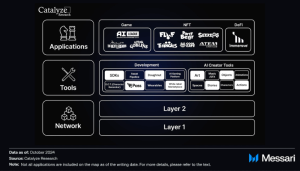Key Insights
- In Q3’22, Livepeer services showed increased demand from apps and developers.
- The core team’s efforts to support Web3 video app development materialized into network usage reaching an all-time-high of ~37 million minutes of transcoded video.
- Demand-side revenue increased 7% in USD terms (up 52% in ETH terms) as a result of increased network usage.
- Supply-side participants remain committed to the Livepeer network as staking rewards decreased 46% in USD terms (up 17% in LPT terms) amid the overall market downturn.
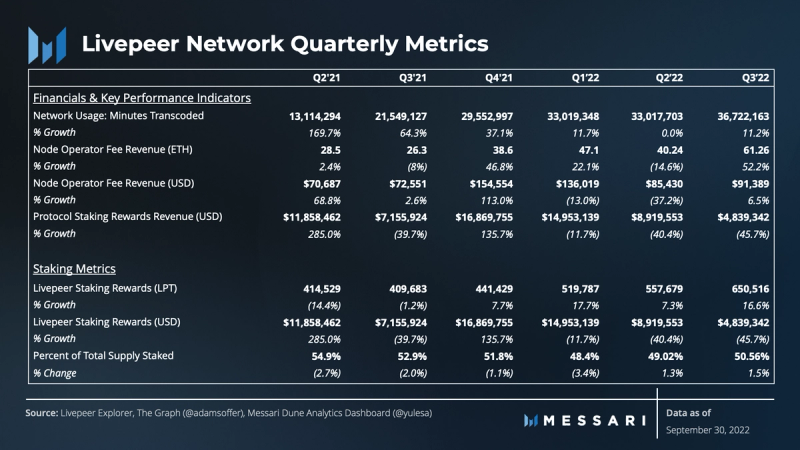
Primer on Livepeer
Building decentralized video apps like Twitch or TikTok requires heavy infrastructure for live streaming. Based on the user’s bandwidth and device, video content needs to be processed — i.e., transcoded — viewable formats. While cloud providers like AWS, Google, or Microsoft are commonplace solutions for video transcoding services, they incur high costs. Livepeer is an open and permissionless marketplace — allowing anyone to contribute compute resources and to compete on price, Livepeer aims to reduce transcoding costs by 10x.
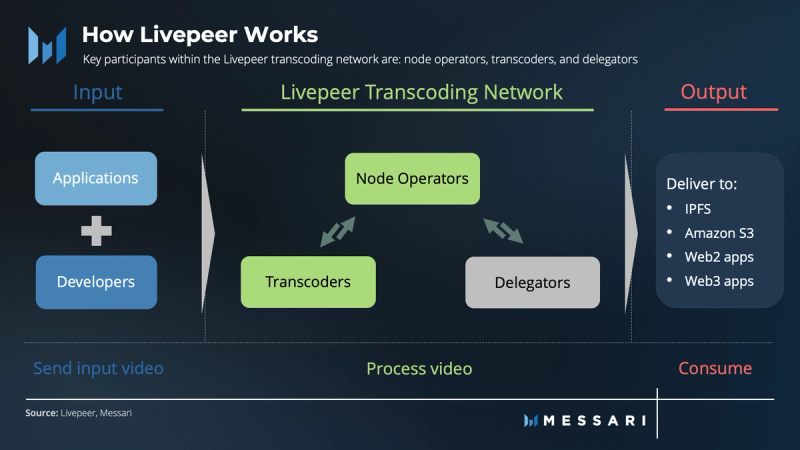
Within Livepeer’s decentralized network, there are three key participants:
- Node operators — called “orchestrators” — route transcoding jobs. The amount of work a node operator can perform is proportional to how many Livepeer native tokens (LPT) it stakes. Node operators earn ETH fees and newly minted LPT rewards.
- Transcoders provide computing resources for node operators and deliver transcoded video content. In return, they earn ETH fees.
- Delegators stake LPT towards effective node operators and help secure the Livepeer network. Staking is rewarded with a portion of both ETH fees and newly minted LPT.
Performance Analysis
Demand for Livepeer services comes from apps and developers in need of video transcoding services. For example, user-generated content apps require streaming infrastructure to broadcast videos to followers.
Network Usage at All-Time-High
Livepeer’s network usage can be gauged by the number of minutes of video transcoded.
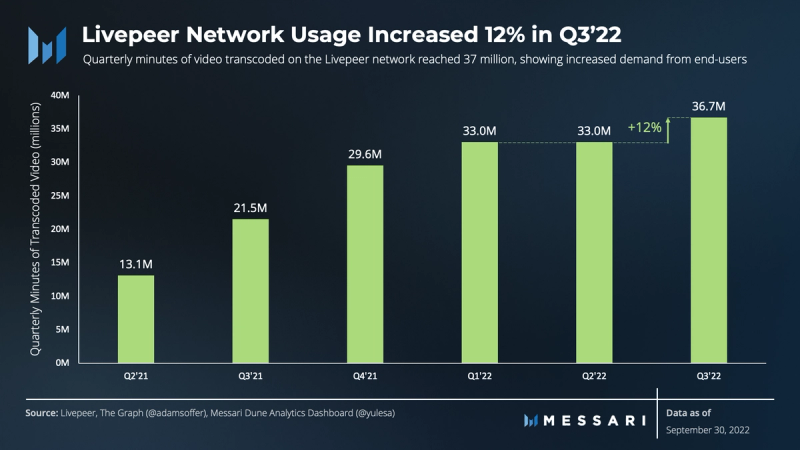
Q3’22 saw a record of nearly 37 million minutes of video transcoded on the Livepeer network. This is a 12% increase from Q2’22 and demonstrates a healthy demand for Livepeer video transcoding services. Demand is expected to continue growing as more Web3-enabled video apps break out beyond the prototype phase.
Network Revenue
Livepeer’s network revenue consists of demand-side and supply-side revenue.
Demand-side revenue comprises ETH fees accrued from transcoding services. Node operators with larger amounts of stake have an increased likelihood of receiving more transcoding work, which, in turn, results in them earning more transcoding fees.
Supply-side revenue consists of revenue from:
- LPT staking rewards (accrued by node operators and delegators), which yields inflationary issuance of the token
- ETH fees for transcoding services (accrued by node operators and transcoders)
The latter doesn’t include ETH fees distributed to delegators, since delegators don’t actively participate in the supply of transcoding services.
Demand-Side Revenue (Transcoding)
Fees from transcoding services are paid to node operators in ETH and are further distributed to transcoders and delegators.
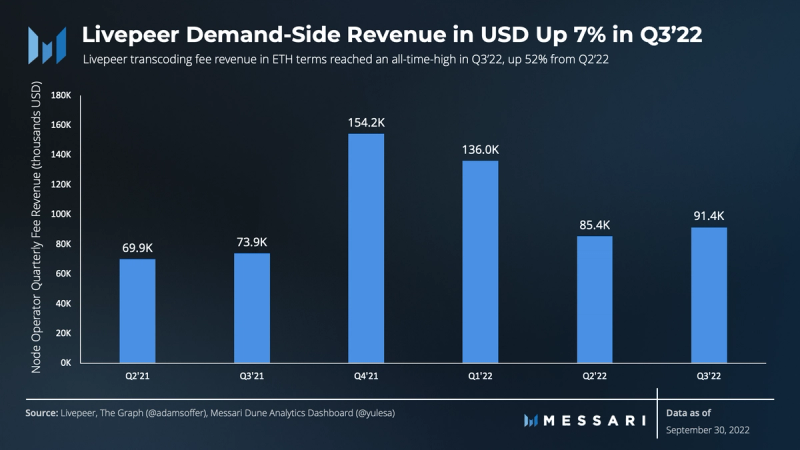
Livepeer transcoding fee revenue reached an all-time-high in ETH terms in Q3’22, up 52% relative to the previous quarter. In USD terms, this corresponded to a 7% increase to over $91,000.
The revenue from transcoding fees is relatively insignificant compared to the revenue from staking rewards. Like other Web3 infrastructure protocols, Livepeer subsidizes its node operators with inflationary rewards. This subsidization enables Livepeer to compete with existing transcoding providers like Amazon and Google by reducing the cost of live video transcoding by 10x. As transcoding fees continue to fall, the number of transcoded minutes needs to continue growing for the protocol to be sustainable.
While the video transcoding market is still relatively small, transcoding revenue has grown proportionally with usage and transcoding fees. Livepeer is well-positioned in a market with significant upside potential.
Staking Reward Revenue
The Livepeer network distributes staking rewards in LPT to node operators and delegators. To provide transcoding services on the Livepeer network, node operators must stake LPT. A node operator’s stake weight comprises their own tokens and those delegated towards them.
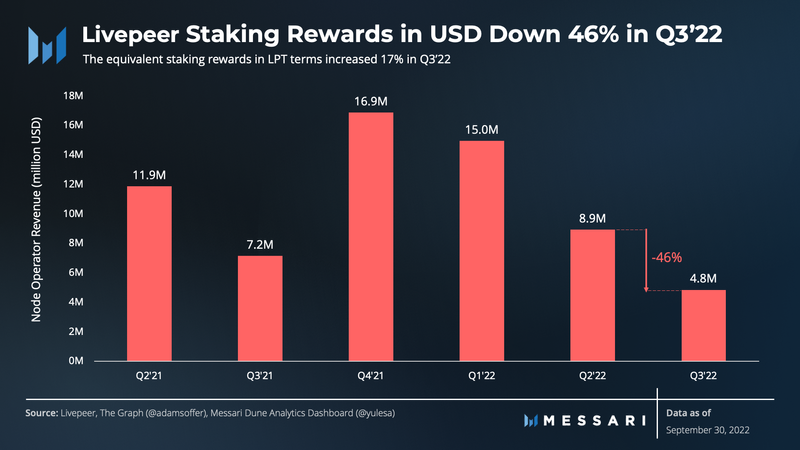
Staking reward revenue in LPT terms increased 17% to over 650,000 LPT in Q3’22; however, when translated in USD terms, it was down 46% to $4.8 million. While this is a far cry from the all-time record of $16.9 million in Q4’21, it’s also a testimony of the resilience of the Livepeer network, given the current overall market downturn. As highlighted in the Staking Overview section below, the steady increase in staking participation shows a continued commitment to the Livepeer network as participants serve increased demand of video transcoding services from end users.
The vast majority of revenue currently comes from staking rewards. As killer social apps are built, it remains to be seen to what extent Livepeer network participants are going to capture value out of increased usage. One way for node operators to capture value is by having larger stakes on the Livepeer network to increase the likelihood of receiving more transcoding work.
Staking Overview
The LPT token follows the Stake-for-Access model, also known as a work token model. That is, Livepeer requires its node operators to stake the native token (LPT) in order to perform work on the network. Node operators’ stake comprises their own LPT tokens (i.e., self stake) and LPT delegated towards them (i.e., delegated stake).
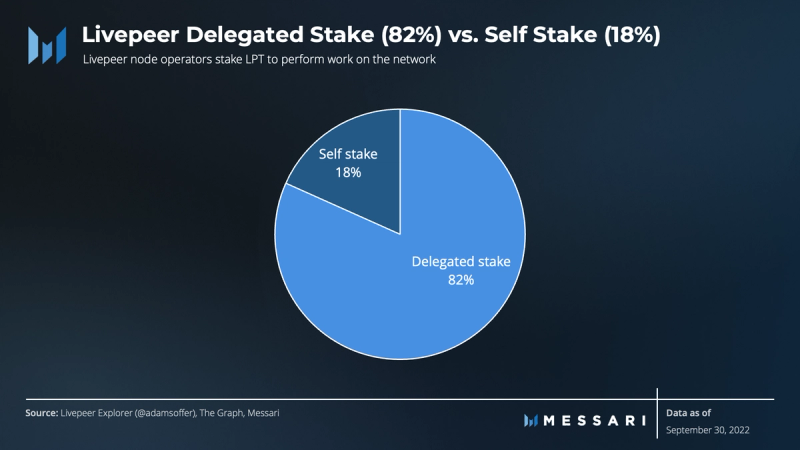
As per end of Q3’22, nearly 13.8 million LPT (out of the total supply of 26.4 million LPT) has been staked by the 100 node operators and the nearly 4,300 delegators on the Livepeer network. Delegated stake accounted for 82%, whereas node operators’ self stake represented 18%.
Our Q2’22 quarterly report found that the Livepeer network participation rate — the percentage of the circulating LPT supply that is staked — remained around the 50% equilibrium threshold since Q4’21. In Q3’22, the Livepeer network participating rate increased above the equilibrium threshold.
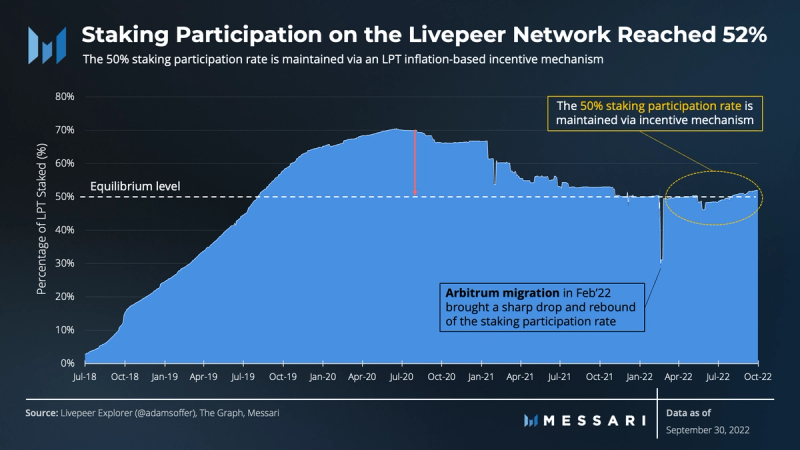
For the first time since the Arbitrum migration in February 2022, the participation rate gradually increased to 52% throughout Q3’22. Livepeer dynamically issues LPT staking rewards to maintain staking participation rate at the 50% target equilibrium level as follows:
- Should the participation rate fall below 50% in a given round, LPT issuance increases by 0.00005%.
- Conversely, if the participation rate passes 50%, inflationary issuance decreases by 0.00005%.
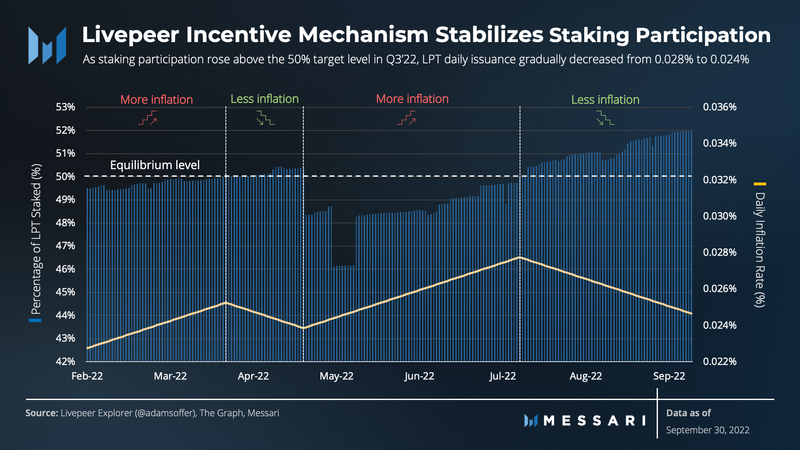
In May 2022, the participation rate dipped towards 46%. It was then followed by a gradual rebound to the 50% equilibrium level and an overshoot to 52% as of the end of September 2022. It remains to be seen how long it will take for the participation rate to return to the target equilibrium level of 50% and what will be the overall impact on LPT token inflation.
These fluctuations should not be regarded as an anomaly but as a feature. They are the result of a dynamic mechanism that balances the participation rate through the inflationary issuance of token rewards. As such, the gradual increase in the participation rate to 52% throughout Q3’22 has led to a gradual decrease in LPT issuance from 0.028% to 0.024%.
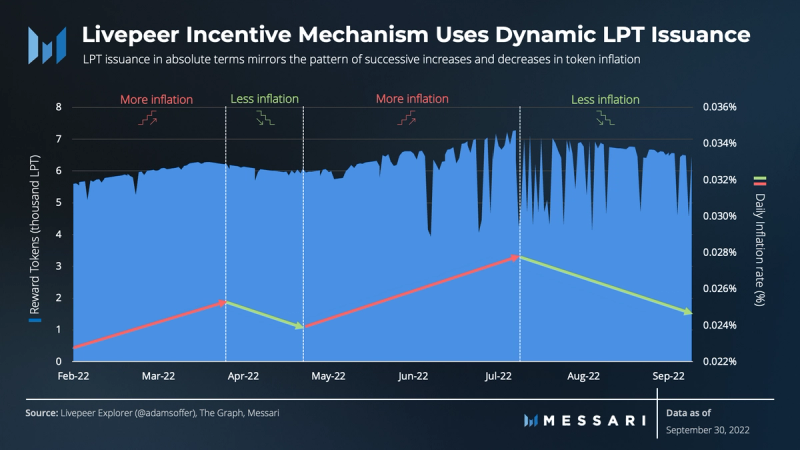
Indeed, the dynamic LPT issuance in absolute terms mirrors the pattern of successive increases and decreases in token inflation. The current decrease in token inflation is expected to continue over Q4’22 until the staking participation rate returns to 50%.
Qualitative Analysis
Development and Governance Overview
Development Beyond Transcoding
Our Q2’22 report discussed the core team’s vision to grow Livepeer’s offering beyond video broadcasting. Several avenues include video ingestion, content delivery, and generic compute capabilities. While scene classification and object recognition have been available in private beta in recent months through Livepeer Studio, the community has yet to fully adopt these features and bring them onto the Livepeer network.
The community is also experimenting with rendering images in the new series of open-source text-to-image AI tools, such as StableDiffusion. The Livepeer network is well suited to serve as scalable and cost-effective infrastructure for doing this type of work, and the existing protocol and payment mechanisms could be easily extended to accommodate similar GPU capabilities.
The core team is focused on supporting the developers of Livepeer-enabled apps as well as promoting Web3-native features in an attempt to drive greater video volumes through the Livepeer network.
In Q3’22, the Livepeer developer team released Livepeer Catalyst — node software for video broadcasters to host a decentralized media server (DMS).
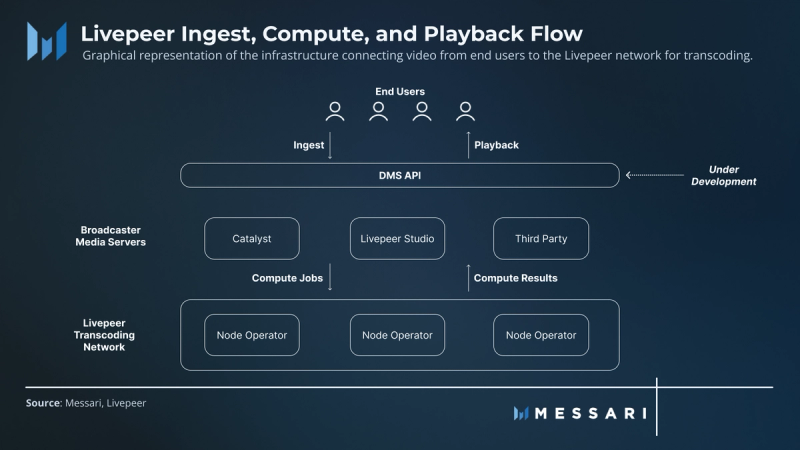
Source: Livepeer Project Update Call Q3’22
Using Catalyst, broadcasters can easily connect to the transcoding network to serve video to node operators and receive transcoded results. Catalyst can thus be seen as a decentralized alternative to Livepeer Studio with transcoding latency improvements.
Further, the Livepeer developer team is creating a standard DMS API for ingestion and playback to end users. For instance, the protocol needs a seamless way for a decentralized YouTube-like project (broadcaster) to ingest video from end users and play back the transcoded results from the Livepeer network.
Livepeer Grants
Livepeer distributed grant funding from the $250,000 Q3’22 grants program to six community-run projects. These include an Orchestrator tooling project from node operator Authority_Null, as well as a few streaming apps OurTube, Clipto, and Lenstube.
While OurTube remains in early phases of development, Clipto is an operational platform where users can order custom video NFTs from creators. Furthermore, Lenstube is a decentralized alternative to Youtube powered by three technologies: Lens Protocol’s social graph, Livepeer’s video transcoding, and IPFS storage of video NFTs.
Governance
Q3’22 saw Livepeer’s first governance vote since its migration to Arbitrum in February 2022. The vote was in response to parameter adjustments from the Ethereum Merge. After The Merge, block time reduced by approximately 10% to a fixed 12 seconds. Because LPT inflationary issuance occurs per round, a ~10% decrease in round time would result in a ~10% increase in LPT reward distribution frequency. In response, LPT tokenholders voted to adjust the Livepeer round time metric from 5,760 to 6,377 blocks. This update ensures that Ethereum’s new round time will not affect the protocol’s standard economics.
Livepeer Ecosystem: Notable Events
Upgraded Livepeer Explorer
The Livepeer Explorer underwent a major upgrade in Q2’22 to aid users monitor network activity and delegate tokens. As a result, stake is more easily delegated to node operators based on performance and expected yield as opposed to solely those with high stake. Since the update, stake has been distributed to smaller node operators at an increasing rate. This has helped diversify transcoding amongst network participants, as well as helped smaller node operators reach profitability. In this case, “profitability” refers to a positive difference between the LPT earned in a round minus the cost of the gas fees incurred to call the reward. The upgrade should continue to unlock increasingly affordable participation in the Livepeer network.
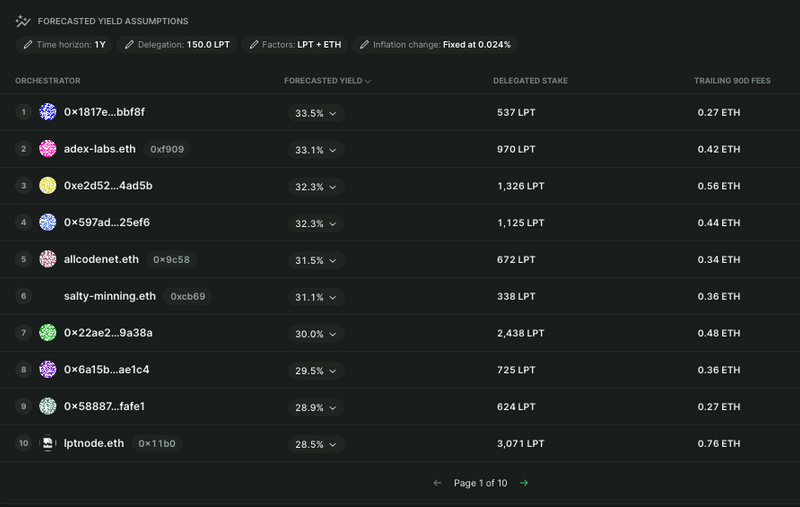
Source: Livepeer Explorer (Screenshot taken as of October 5, 2022)
Livepeer at Mainnet 2022
Livepeer Founder Doug Petkanics met the Messari team during the annual Mainnet conference in September. As part of a 30-minute panel session, we explored the killer social apps enabled by Web3 primitives and infrastructure. We expect unique, permissionless protocols to grow in market share as the industry matures. In line with this, Livepeer Studio’s focus for the rest of the year is aiding the productization of Web3 apps in the social media, creator, and metaverse gaming economies.
Roadmap
Since Q2’22, Livepeer Studio shifted focus to funding and developing Web3-native video-enabled projects. These efforts have translated to over 100 new projects building Livepeer-powered apps in 2022.
Livepeer Studio’s focus on Web3 apps is expected to increase Livepeer fee revenue from usage. Current apps built on Livepeer include:
- Huddle01 — a Web3 native video meeting app
- The402 — a fresh YCombinator company that uses Livepeer for creator live streaming
- Web 3 Edi — a broadcasting educational platform
- Iris — a Web3 social creator platform built on Lens Protocol
In addition to its specialization in processing video for apps, Livepeer is exploring on-chain integrations of livestreams and video snippets. The Verifiable Video Streams approach introduces immutable links of video to the blockchain using public key addressed streams. It will introduce the verifiability of both the content and ownership of videos. Videos can be tied directly to end users and content-addressed streams can be verified based on unique hashes without needing to download a video in its entirety.
Closing Summary
Livepeer is expanding its services beyond transcoding as it cements its position as the video infrastructure and services layer for Web3. The network held strong throughout the bear market, maintaining a committed community of supply-side participants serving increased demand of video transcoding services from end users.
Demand on the Livepeer network is expected to continue to grow as new Web3-native apps break out beyond the prototype phase. At the same time, Livepeer needs to accrue more revenue from transcoding services as opposed to rewards to ensure a resilient ecosystem. It also needs to continue its efforts towards a more uniform staking distribution and a larger base of node operators should demand significantly pick up.
As the Livepeer network attracts more demand and expands its network of nodes and services, it welcomes the possibility of becoming a prominent infrastructure player for the video broadcasting stack, ingest and delivery layer, and eventually the general compute industry.
Let us know what you loved about the report, what may be missing, or share any other feedback by filling out this short form.
This report was commissioned by Livepeer, a member of Protocol Services. All content was produced independently by the author(s) and does not necessarily reflect the opinions of Messari, Inc. or the organization that requested the report. Paid membership in Protocol Services does not influence editorial decisions or content. Author(s) may hold cryptocurrencies named in this report. Crypto projects can commission independent research through Protocol Services. For more details or to join the program, contact ps@messari.io. This report is meant for informational purposes only. It is not meant to serve as investment advice. You should conduct your own research, and consult an independent financial, tax, or legal advisor before making any investment decisions. The past performance of any asset is not indicative of future results. Please see our Terms of Use for more information.

